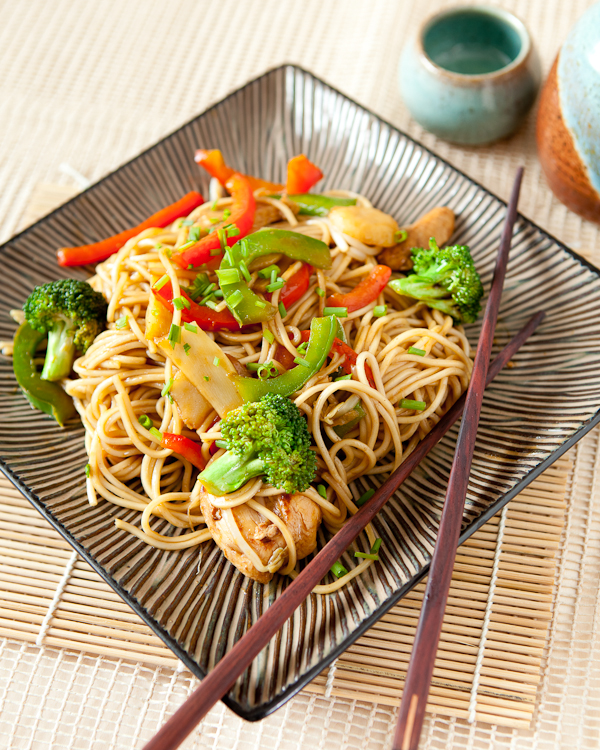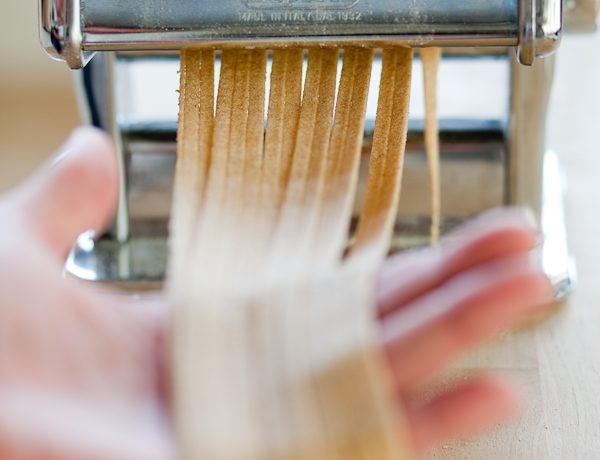I love noodles. Specifically I love lo mein, chow mein, chow fun, mei fun, you name it. I like non-Asian style noodles too, but I can really dig Chinese take-out noodles like nobody’s business. Often when I get the hankering for noodles of this type I end up not being able to scratch that particular itch either because the Chinese restaurants are closed or too far away, or I try to make regular Italian pasta work. But no more friends, because I figured out how to make my own lo mein at home.
The other thing that prompted my noodle binge at this weekend was my purchase of a wok! A nice, cheap steel wok. None of these fancy celebrity chef woks for me, no, I got mine at Dragon Trading-US, which if you haven’t been is an experience all it’s own. Think giant spooky warehouse with a leaky roof stocked from floor to ceiling will all manner of new and used restaurant supply stuff from the typical to the bizarre. The place is booby-trapped with motion activated Hello Kitty figurines which makes it impossible to move throughout the store without being followed by electronic voices welcoming you and telling you to have a nice day. It’s a little unnerving. But if you’re looking for a workhorse of a wok, this is the place. They have woks there large enough to cook a horse too. If cooking a horse was something you feel like you need to do. You cannot cook a horse in my wok though, unless it is very small.
I spent the better part of my day last Friday burning off the manufacturer’s protective coating from my wok (tough to do on an electric stove) which filled my apartment with acrid and probably toxic smoke. Once I had that done I had to go about the task of seasoning it, which involved many rounds of heat + oil. On Sunday I gave it a final seasoning using leftover bacon fat (pork being the traditional wok seasoning fat anyway) and then I deemed it ready for use. Unfortunately a wok is only moderately effective on an electric stove because of the simple fact that there aren’t any active flames to wrap up around the edges to heat up the sides. I found that it did a pretty good job overall, although it’s possible I over-filled it to begin with which meant there wasn’t quite enough heat for the flash stir-fry effect.
I’d picked up a bottle of hoison sauce and some wheat lo mein noodles at World Market before Christmas, and so I pretty much just winged the recipe. I used a red and a green pepper, broccoli, a can of water chestnuts, a can of bamboo shoots, some bean sprouts and a couple of chicken breasts to balance the noodles. I marinated the chicken in soy sauce briefly, then sautéed it in sesame oil. Once it was cooked I tossed in the veggies and stir-fried the whole thing for a couple minutes, then added in two or three generous tablespoons of hoison sauce. I added the cooked noodles, a little more hoison sauce and some soy sauce and that was it! Delicious!
Chicken Lo Mein Recipe
Ingredients
1 lb lo mein noodles
1 tablespoon sesame oil
1 green pepper, cut into bite size strips
1 red pepper, cut into bite size strips
1 small head of broccoli, cut into small pieces
2 cups bean sprouts
1 small can of water chestnuts
1 small can of bamboo shoots
2 chicken breasts, sliced into strips and marinated in soy sauce
Soy sauce to marinate chicken and for sauce, about 1/4 cup)
3 tablespoons hoison sauce
Cook the noodles per package instructions until al dente. Rinse with cold water, set aside. Heat a wok very hot, then add sesame oil. When oil shimmers and is nearly smoking, add chicken. Toss in the oil until cooked through, about 4-5 minutes. Add in the vegetables, bean sprouts, water chestnuts and bamboo shoots and stir fry for several minutes until desired doneness. I prefer crunchier vegetables so I only stir-fried for a minute or two. Add in the hoison sauce, toss to coat. Add in the noodles and toss with the sauce and vegetables. Cook until noodles are hot. The noodles will absorb the sauce, add in a little more soy and hoison sauce as needed. Serve with chives snipped on top.
After Action Report
This recipe is in no way authentic (then again, neither is takeout Chinese food), but it was certainly tasty and I’ll definitely make it again. I’d love to experiment with lemongrass and cilantro in a recipe like this. I’d also like to try out some of the Vietnamese vermicelli recipes, which I love as well. You can use virtually any kind of vegetables here like edemame, snap peas, even cabbage. The flavoring is highly dependent on the hoison sauce, which kinda feels like cheating but sometimes using something out of a jar is just the way to go. In general I feel like not matter what I cook at home it’s going to be healthier than takeout or restaurant fare, if only because I tend to use less butter. However, in this case I’m not entirely sure that this recipe was cheaper or healthier than what you’d get at a take-out joint. However, being able to control how crisp the vegetables are definitely beats take-out by a mile!





3 Comments
Laurab @foodsnobstl
January 25, 2011 at 3:02 pmWe bought wok this weekend too! Have you ever made your own stir fry sauce? I don’t love the bottled stuff.
ShootToCook
January 25, 2011 at 3:16 pmI have not made my own stir fry sauce but I’d love to try. Do you have a recipe you’d recommend? I’d much rather a home made solution rather than a bottled one where possible …
Mike
February 4, 2011 at 12:25 pmYo Jonnie,
So I read this a week and a half or so ago and meant to recommend a fantastic book/cookbook to you. ‘The Breath of a Wok’ by Grace Young and Alan Richardson (0743238273). I collect cookbooks and food essays, and this is one of my favorites. It won the IACP Cookbook Awards. REAL authentic Chinese cooking. It’s all within the context of the history of Chinese food and gives wok buying advice, etc.
Happy Chinese New Year! – m